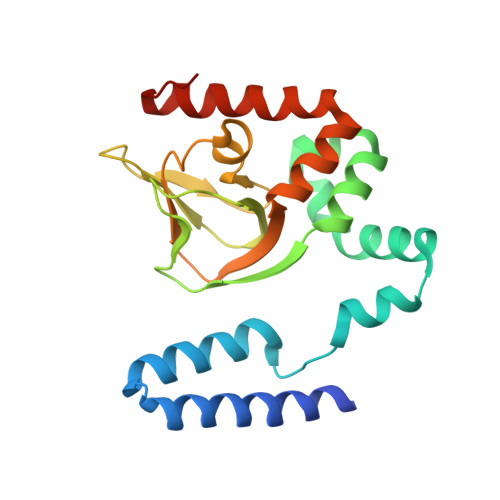Tetramerization dynamics of C-terminal domain underlies isoform-specific cAMP gating in hyperpolarization-activated cyclic nucleotide-gated channels.
Lolicato, M., Nardini, M., Gazzarrini, S., Moller, S., Bertinetti, D., Herberg, F.W., Bolognesi, M., Martin, H., Fasolini, M., Bertrand, J.A., Arrigoni, C., Thiel, G., Moroni, A.(2011) J Biol Chem 286: 44811-44820
- PubMed: 22006928
- DOI: https://doi.org/10.1074/jbc.M111.297606
- Primary Citation of Related Structures:
3U0Z, 3U10, 3U11 - PubMed Abstract:
Hyperpolarization-activated cyclic nucleotide-gated (HCN) channels are dually activated by hyperpolarization and binding of cAMP to their cyclic nucleotide binding domain (CNBD). HCN isoforms respond differently to cAMP; binding of cAMP shifts activation of HCN2 and HCN4 by 17 mV but shifts that of HCN1 by only 2-4 mV. To explain the peculiarity of HCN1, we solved the crystal structures and performed a biochemical-biophysical characterization of the C-terminal domain (C-linker plus CNBD) of the three isoforms. Our main finding is that tetramerization of the C-terminal domain of HCN1 occurs at basal cAMP concentrations, whereas those of HCN2 and HCN4 require cAMP saturating levels. Therefore, HCN1 responds less markedly than HCN2 and HCN4 to cAMP increase because its CNBD is already partly tetrameric. This is confirmed by voltage clamp experiments showing that the right-shifted position of V(½) in HCN1 is correlated with its propensity to tetramerize in vitro. These data underscore that ligand-induced CNBD tetramerization removes tonic inhibition from the pore of HCN channels.
Organizational Affiliation:
Department of Biology and Consiglio Nazionale delle Ricerche-Istituto di Biofisica, University of Milan, Via Celoria 26, 20133 Milan, Italy.















